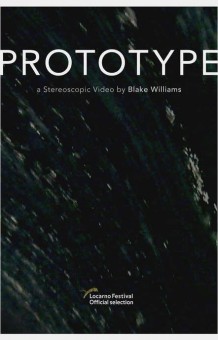Prototype, the first feature-length effort from Toronto filmmaker and movie critic Blake Williams, clocks the beginning of end times as 1900. That’s the year that the most lethal natural event in American history struck the once-bustling commercial center of Galveston, Texas, claiming approximately 8,000 lives. This stunning new experimental film opens on a series of photographs of the hurricane’s aftermath, surveying destruction of biblical proportions. Williams brings these drab tableaux to life via the first of many formal maneuvers that specifically employ anaglyph 3D projection, as broken wagons and snapped trees jump out in the foreground as if from a pop-up book. (There’s a 2D version making the rounds as well, but that defeats the purpose: The ability to create a disparity between what’s shown to the right and left eyes is a crucial component of what Williams is doing here.)
This solemn contemplation of the devastation forms the prologue to a surreal, enigmatic journey through the century that followed and beyond, up to the manmade apocalypse toward which the Earth is currently hurtling. Williams designates the Galveston disaster as a tone-setter for a planetary death spiral. Following the reanimated photographs, a bundle of computerized streaks churn until they sharpen into the shifting tides of a dark ocean, the same note on which the film concludes. Humanity fills the space between nature’s turbulent purges, technology being the chosen symbol of our reckless evolution and the moving picture being the chosen symbol of that technology. We’ve been on Earth for mere seconds in the grand scheme of existence, and our time is nearly up. Order will be restored, and Galveston, as well as Prototype, stand as testaments to the primeval violence of the process.
Starting with the clang of a train speeding along tracks that slowly fuzzes into its own disintegration loop, vague markers of industry fill the sensible 63-minute runtime. (Williams knows not to wear out his welcome, and adheres to a surprisingly perceptible structure that staves off the aimless-floating feeling that accompanies some of the more opaque avant-garde. There’s a reason this oddity is getting a showing at Austin’s Alamo Drafthouse and a review in The A.V. Club.) The constant whir of machinery blankets the audio with Lynchian white noise, while visual textures evoke the flicker and grain of a filmstrip or the red-green-blue particles of an analog television screen. The rounded midcentury face of Philco’s Predicta model TV is a central totem of Williams’ framework, futurism and nostalgia and Americana all tied up in a single package.
Facsimiles of the Predicta house most “shots,” the scare quotes speaking to an approach that recalls Kiarostami’s recent 24 Frames in its isolation of discrete images. Williams doesn’t usually cut directly from one shot to the next, often punctuating archival samples with a few seconds of blackness. He resists the tyranny of the edit through inventive stylistic sorcery: Objects melt into other objects, sometimes remaining in the liminal half-space long enough to suggest a connection between, say, the rising sun and a nuclear explosion. Williams also sets up juxtapositions by sticking two pseudo-TVs in a single frame, effectively reclaiming picture-in-picture from the artistic prison of ESPN game-day broadcasts. Most notably, he picks up where Godard left off in Goodbye To Language and gives the viewer the authority to edit in-eye by closing one or the other when two different images overlap on the screen. In the most jarring moment, black and white coexist in a single space. It feels unnatural, forbidden, like a perversion.
Just as Williams has given us a compelling vision of the art form’s future by reconfiguring its history, he blows it all up. The final “act” dives into the abstract deep end previously charted by Peter Tscherkassky in his excellent Outer Space, using flurries of defamiliarized found footage as an alienation offensive. The senseless chaos of this passage gestures back to the Galveston hurricane, and to a more existential Armageddon in our media-saturated age. On a soul-deep scale, Williams has tapped into a conflict—the human race’s apparent insistence on exterminating itself—and channeled it into material cinematic terms that continuously challenge themselves. There’s a lot to ponder in Prototype, not least in the confounding coda that suggests a note of hope for rebirth, but the film’s powers are visceral as much as (if not more so than) they are cerebral. His expressions of destruction and decay transcend language or logic, verging on the cosmic. Not since Leviathan’s choppy seas has water inspired such immediate, terrible awe. One day, it will swallow us again. Who’s not afraid of drowning, in a flood or the murkier deeps of time?
The Museum Of The Moving Image is presenting an exclusive New York City run of Prototype from August 31 until September 9. More info here.


 Keep scrolling for more great stories from A.V. Club.
Keep scrolling for more great stories from A.V. Club.